From Torpedo boats to destroyers
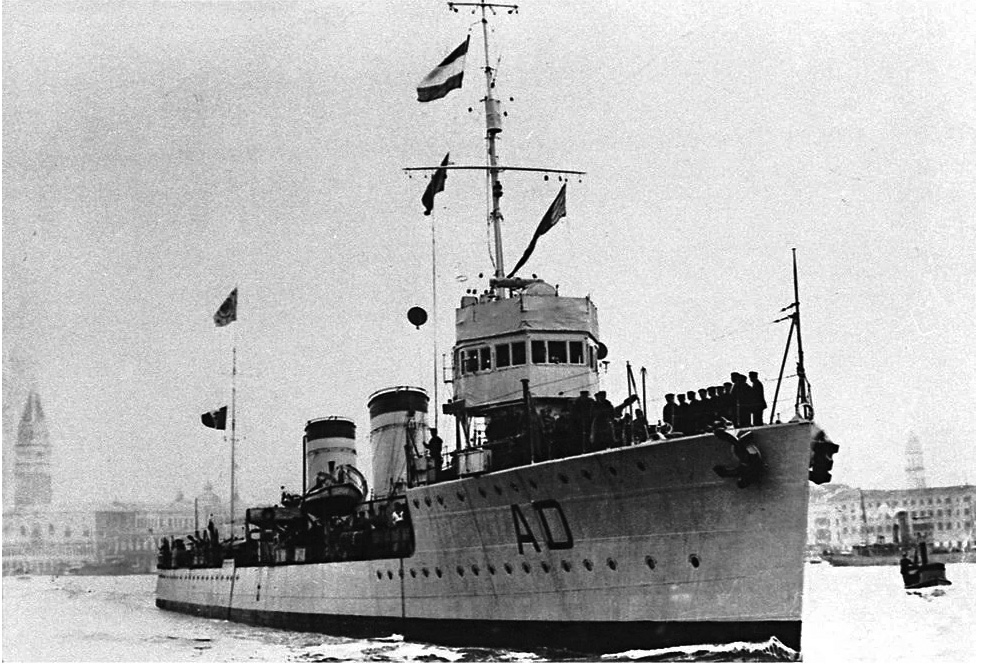
Audace in 1918
Development of Italian torpedo boats had a lot to do with its immediate Adriatic neighbour and rival, Austria-Hungary. Indeed it’s a subject of the Empire which in the late 1860s and early 1870s developed for the first time a new kind of naval “mine”, self-propelled, later called torpedo due to its shape. The contraption pioneered by Luppis was further developed by Thornycroft, the local branch of the British manufacturer. The first torpedo boats started to replace old spar-torpedo launches in the 1870s and in 1875 thanks to new propulsion systems, gradually took its place into the maritime arsenals.
Italian Torpedo Boats
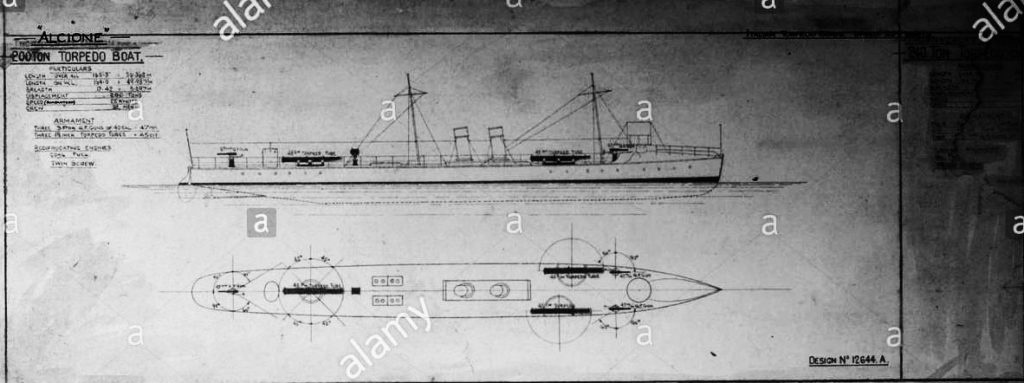
Alcione class TB blueprint
The young Italian Navy, shaped after the independence, was not long to understand the advantages of the torpedo. The first Torpedo boat in service was the Nibbio (1878), a
Thornycroft-built vessel. She was later reclassified as a 4th class boat named 1T in 1886, and was discarded in 1904.
Fourth class Italian TBs
She was followed by other prototypes and small series ordered from other British yards:
-Avvoltoio (1879): Yarrow – 25 tonnes, 26.2 x3.3 x 0.95 m, 1 shaft VTE, loco boiler, 420 ihp, 21.3 knots, armed with two 14-in TTs, crewed by ten.
-Sparviero class (1881): Yarrow – 39 tonnes, 30.43 x 3.81 x 1.49, 1 shaft VR loco boiler 620 hp 22.5 knots, same plus one 25 mm twin-barreled Hotchkiss gun (Sparviero, Falco)
-Aquila class (1881): Thornycroft – 34.5 tonnes, 29018 x 3.28 x 1.47 m, 1 shaft VDE, 475 ihp 20 knots, armed as Sparviero (Aquila, Gabbiano)
Deserving a special attention was the first Italian built TB, called the Clio, built at Orlando in 1882.
The boat was designed by engineer director Luigi Borghi. This fourth class TB was stored aboard thr capital ship Duilio, which acted as mothership. The boat was 30 tonnes, 23.35 x 3 x 1.53 m, with a shaft TER and loco boiler, 250 hp for 18 knots.
Yet Italy ordered a whole serie of fourth class boats to Thornycroft, Odero, Orlndo, Pattison, and Guppy in 1882-85:
-Aldebaran (28 boats), Euterpe (14), Mosca class (4). All these coastal boats were renamed in the 1885-86 period and discarded in 1907-1910.
After a budget restrained forced vacancy, the admiralty ordered larger 2nd class models in order to carry out exercises with the fleet:
These were the four Ya class boats, two built in UK in Yarrow in 1894 and two in Italy at Venice Nyd in 1895.
Specs: 108.5 tons, 41.18 x 4.27 x 1.54 m, two shafts VDE, 2 loco boilers, 164 ihp, 22-26 knots. Armed with two 37 mm/25/20 Revolver guns, 3-4 14-in TTs.
Schichau 3rd class Torpedo boats:
Perhaps reflecting a change in policy of the Italian governments, leaning towards the central Empires, a large number of third-class TBs were ordered in 1886-1895. They were all discarded before 1914.
-19 of the Type 78 tonnes (39.84 x 4.8 x 2 m), 1 shaft VDE loco boilers 902-1080 ihp 21-22 knots
-26 of the same built by Odero. Rated power around 1100 ihp.
-12 of the same, by Cravero.
-2 Naples type (Guppy). same as the others, but experimental.
-16 of the same, by Pattison. Rated for 1082 ihp.
-18 of the same, by Ansaldo. Rated for 1079 ihp.
First class TBs:
From 1888, the admiralty resolutely aimed at giving the fleet sea-going ships. The first five were a class of 5 boats ordered at Schichau in 1888.
The Aquila group were 137 tonnes boats, 47.6 x 5.1 x 2.2 m, 2 shafts VDE, loco boilers 2180 ihp, 24 knots, armed with two 37 mm revolver and three 14-in TTs.
In 1898, Ansaldo built the Condore, entirely Italian, a 138 tonnes 48 m long, with two 37 mm/25 Revolver guns and two TTs, and the Pelicano, ordered in 1899 to Odero, but much larger. The Pelicano was a 181 tonnes FL vessel, 48.7 x 5.7 x 1.53 m boat propelled by two shafts VTE and three Blechynden boilers, for 2740 ihp, 21 knots. Armament as the former.
The admiralty then ordered five years later in Schichau a serie of new torpedo boats, larger, faster and better armed.
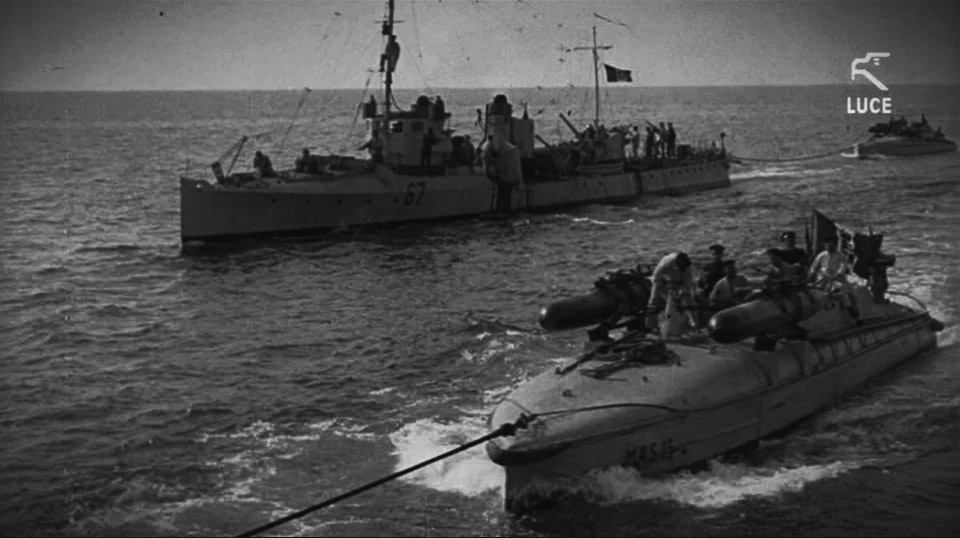
PN-65 and MAS-15 in the Adriatic.
Italy operated alongside destroyers, no less than 93 torpedo boats, and 403* MAS-boats of all types. This was quite a deterrent force for the Austro-Hungarians.
*Based on the numeration until 1918. 19 were cancelled.
The six Sirio class (1905) displaced 206 tonnes, for 51 x 6 x 1.6 m. They were propelled by two shafts VTE fed by Schultz-Thornycroft WT boilers for a top speed of 25.5 knots (3100 ihp). They were armed by three 47 mm/40 QF Krupp guns and three 17.7 in TTs.
The same year, four ships of the Pegaso class were ordered to Pattison in 1905. They were very similar except the armament of two Vickers 57 mm/43 guns (3 pdr), one 47 mm/43 (2-pdr) and three 17.7 in TTs.
Apart the Aquila class discarded in 1912-14 the others saw service during the great war.
Before and during the war, many other modern torpedo boats were built:
-14 Pegaso class boats (1906) – 216 tonnes, 50 x 5.3 x 1.7m, 2x VTE boilers 2900 ihp 26 knots
-4 Orione class boats (1906) – 220 tonnes, 52.6 x 6 x 1.5m, 2x VTE boilers 2900 ihp 25 knots
-36 PN class boats (1911-13) – 120 tonnes, 42.5 x 4.6 x 1.4m, 2x VTE boilers 3200 ihp 27 knots
-35 PN serie II (1916-18) – 170 tonnes, same, 2x VTE boilers 2700 ihp 27 knots
-2(6) PN serie III (1918) – 195 tonnes, 45.7 x 4.6 x 1.7 m, 2 turbines, 2 boilers 3500 ihp 27 knots
Early Destroyers

The first Italian destroyer was elaborated about the same time as the other Nations: This was the 1898 Fulmine, possibly inspired by the Spanish Audaz.
The Fulmine (“lightning”) was designed by the general inspector of the Naval Engineering bureau, Ernesto Martinez. It was inspired by British and German high seas TBs of the time. This ship allowed local shipbuilding industry to reach a new level of expertise, but the end product as a result was mediocre: Only the armament was a good fir, whereas the frail hull had many structural problems and the projected top speed of 26.5 knots was never reached.
The Italian destroyer was only a serial prototype, a testbed to apply ideas and techniques, not intended for long term service. This was reserved for the next six boats of the Lampo class of German construction, and the Nembo and Soldato, which built on regular improvements. In the years following her completion, the Fulmine underwent many armament changes, and after several exercises ended for the formula of a single 76 mm/30 gun forward (3-in) and three 57mm/43 (12-pdr) QF guns and the 356 mm torpedo tubes on axial posts.
Before 1910, she was used by the physicist Domenico Pacini for a series of experiments on air ionization.
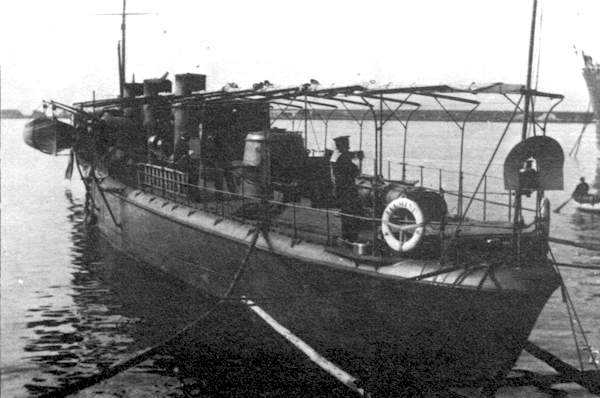
Despite this semi-experimental state, the Fulmine did saw active service during the Italian-Turkish war. On April 10, 1912, she teamed up with the armored cruisers Carlo Alberto and Marco Polo, and the the auxiliary cruisers Città di Siracusa and Città di Catania plus the torpedo boat Alcione as an escort and distant cover for them to shell the city of Zuara. The latter was indeed known as an arrival point for clandestine hardware and war material for the Turkish Ottoman army. This was followed by a fake landing simulated by the steamships Sannio, Hercules and Toscana.
When the great war broke out, the Fulmine was aggregated temporarily to the Fifth destroyer squadron comprising boats of the Nembo class, notably the Borea, Turbine, Espero and Aquilone. She was however in limited service in 1915 as Italy entered war with the entente. Considered as obsolete,
the Fulmine carried out escort duties and ASW patrols near the coast. She was discarded in May 1921, a nice performance for a 1890s prototype.
Development
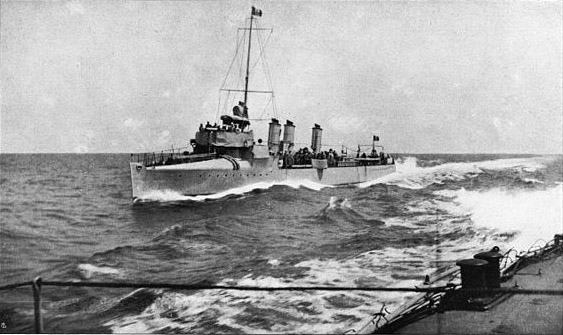
The next classes were much more refined. The Lampo class for example was German-built in order to take more ideas about future domestic developments. The Schichau design was typical of the Hocheseetorpedoboote, including a turtleback forecastle and a ram bow. They had however British Thornycroft boilers and could reach 2000 nautical miles at cruising speed. But they were very fast at 30 knots, which was their main advantage, were strongly built and thus should take on heavy weather, something the Fulmine could hardly do. But the reality showed this was not the case. They were rather poor seaboats. Armament varied among ships, but ended about the same as Fulmine. They served actively during the Italo-Turkish war and patrolled along the coast of Africa, Italy, the Thyrrenian sea with the 6th Destroyer Division, and were discarded in the early 1920s.
The next class, Nembo, also six vessels, were a product of the Pattison shipyard of Naples, based on a British Thornycroft model and reflecting the “Thirty-knotter” style of British early destroyers. They had no forecastle but a turtleback forward deck, displaced 380 tonnes, were 63 m long, and reached 30 knots with VTE engines. They could also be fitted for minelayer. Their career reflecting the Lampo class, and three were lost in action during the great war.
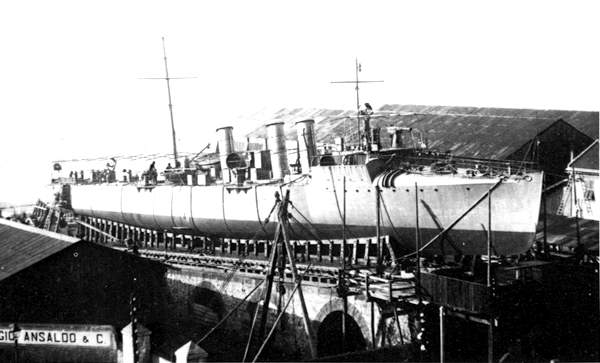
The Soldati class was much posterior to the first two, of superior tonnage and armament, but as the cost as speed. They were studied and built by the Ansalso Yard at Genoa. The admiralty wanted a Nembo type back to 28 knots, therefore they were called the “nembo modificati tipo 28 nodi“. They burnt coal, displaced 412 tonnes fully loaded and reached 28.79 knots in trials but their main advantage was their armament: Four 3-in/40 guns and three 17.7 in (450 mm) torpedo tubes, plus fitting to carry ten mines. This configuration was so successful the previous Nembo were rearmed that way. They burnt coal in their three Thornycroft boilers and the output was 6000 ihp (on trials they reached 6392 ihp). Normal speed was 28 knots, 28.5 as designed. In practice to reach 400 nautical miles this as back to 23.5 knots. The class comprised the Artigliere, Bersagliere, Corazziere, Garibaldino, Granatiere, and Lanciere for the first group, launched 1906-07.
The second group consisted of three boats from the same yard, launched 1909-1910. Apart oil burners they were identical, with a top speed of 29.11 knots on trials. The class comprised the Alpino, Fuciliere and Pontiere. Like the previous classes they were all reclassed as torpedo boats. Only one was lost, Garibaldino in July 1918 during the night at Villefranche, rammed by accident by the HMS Cygnet. Another one was ordered by China, as Ching Po, but requisitioned and purchased by the Italian government in 1912. The Ascaro had mixed boilers and she was the last stricken, in 1930.
The first fleet destroyers
The real revolution came with the “I” class (for Indomito). This was a brand new serie of six 770 tonnes vessels all fitted with a true forecastle, more in line with the new fleet destroyers of the decade. The Indomito class were the forerunners of a long serie of “tre tubi” “tre canne” or “three-pipe” ships, which lasted until the Palestro/Curtatone class of 1919-23. Many of these were still active when WW2 broke out, reclassed as destroyers. The six vessels were launched in 1911-13 at Pattison of Naples.
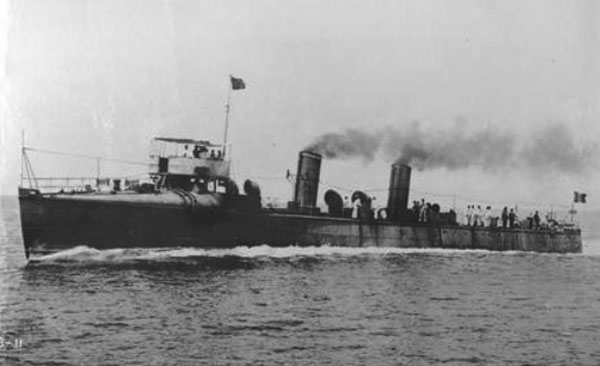
Destroyer Espero
They enjoyed a radical upgrade in armament thanks to their large size: One 120 mm/40 (4.7 in) gun on the forecastle, four 3-in guns, but two axial 450 mm TTs. The large size mostly was used to accomodate large engines, with a total output of 17,600 ihp, enough for a top speed of 35.8 knots. For Italian destroyers they were a landmark in design and enjoyed a considerably long career: Of the six ships of this first class, one was sunk in 1915, another in 1916, three made it to 1937 and one in 1944, changing hands.
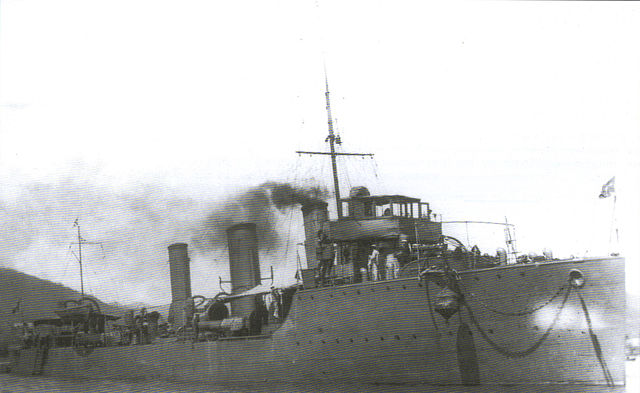
RN Impetuoso of the Indomito class (1913)
Other yards soon were ordered the same designs: Orlando with the Ardito and Audace (four ships). With wartime, emergency saw the construction of eight ships (and not six), the improved Pilo in 1915, built Odero, Sestri, but two, ast Pattison. The main difference was the removal of the 120 mm gun, replaced by four 76 mm in all, and four TTs, on single broadside mounts. They all took part in both WW1 and WW2 (but Nievo, stricken in 1938).
Wartime ‘three pipers’
In 1916, the admiralty received a very unusual, large destroyer at 1170 tonnes FL, originally built for Japan as Kawakaze by Yarrow and resold to Italy, renamed Intrepido and then Audace. She replaced the first of the name and was also active during WW2.
The last “three pipers” were the classes Sirtori (4 ships from Odero, 1917) and eight La Masa class (1917-18) from the same yard, 770-850 tonnes vessels derived from the Pilo class, and finally the “Generale” class started before the end of the war, launched in 1921-22 and completed until 1923. They were improved versions of the latter, six vessels also built at Odero. A firth serie was planned but finally cancelled. In between at Orlando, Leghorn, the admiralty wanted an improved “Audace” (not the British vessel!), reaching a displacement of 1076 tonnes fully loaded.
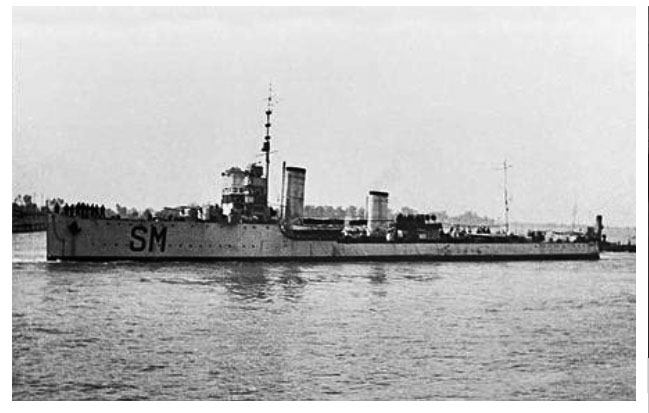
San Martino (Palestro class)
Characterised by a taller hull, more seaworthy, and two funnels, they were launched in 1919-1920 and therefore only participated in WW2. The four Orland-built Curtatone class were virtually repeats of the Palestro class, but larger, at 1214 tonnes FL. On trials they reached 33.6 knots, but this was down to 32 standard. They were better armed, introducing for the first time triple banks of torpedo tubes, still of the light 450 mm model. In WW2 they served as torpedo boats.
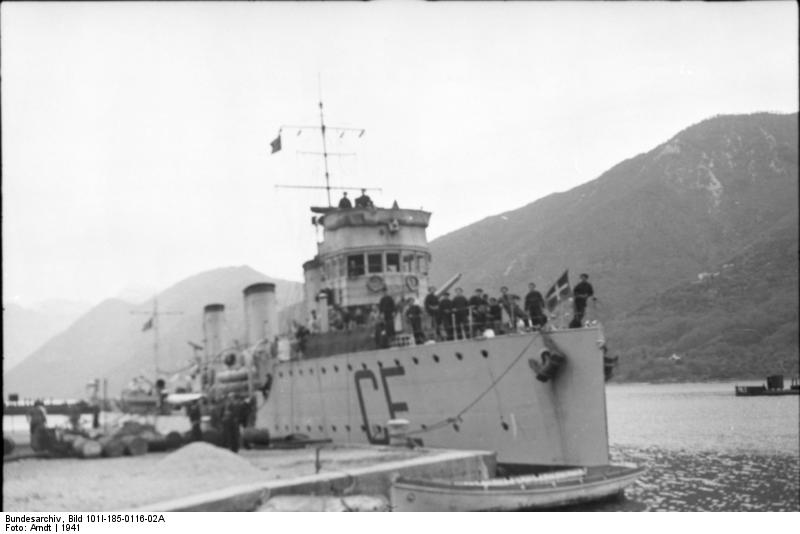
Generale Antonio Cantore
Italian flotilla leaders
Like for other fleets, the need for flotilla leaders appeared clearly in 1912 and the admiralty ordered several models to different yards over a long period of time. As a result three very distinctive classes: The three Perio class, from Ansaldo were powerfully armed, 1216 tonnes, 32 knots leaders well armed with six 102 mm guns and four TTs.
Started before the war they were completed in 1915 and active during WW1 (one sunk, two discarded in 1938). In 1914, a new serie was started for Romania. They were larger, built at Pattison of Naples, and with three-funnels. The Aquila class will comprise the Aquila, Falco, Nibbio and Sparviero were requisitioned in 1915 while in construction and renamed (former names Vifor, Viscol, Vartez and Vijelie). Two were completed in 1917 and saw little service, one in 1918 and one in 1920. Two were resold to Romania, two served until 1939 and were transferred to Spain as an help to the Nationalist Fleet (see the respective sections).
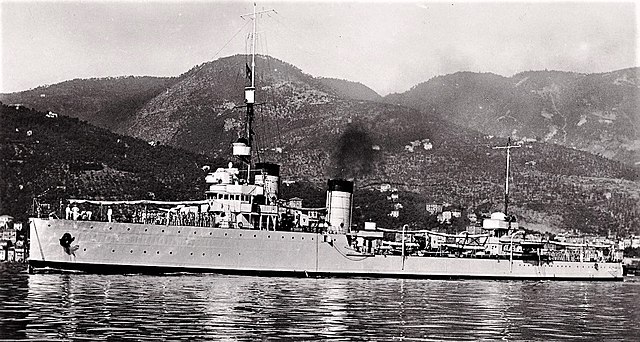
Destroyer Pantera, of the Leone class. In service after the war, this was one of the most powerfully armed destroyer in the Mediterranean (before the French heavy destroyers comes in).
Meanwhile, planned as soon as 1913 the 5,000 tonnes “esploratori” designed by Nabor Soliani evolved into unarmored 2000 tonnes light scouts laid down in 1914. They were named Mirabello, Carlo Alberto Racchia and Augusto Riboty, launched in 1915-16 and completed in 1916-17. Probably the best Italian destroyers of WW1 by far. One was lost in 1920 on a mine near Odessa, while supporting the white Russians, the two others participated in WW2 (one lost). Reaching 1784 tonnes standard and 1972 fully loaded, the Mirabello class were heavily armed and very fast, worthy of small scout cruisers. The Riboty was unique as having a single QF 6-in gun (152 mm) and seven 102 mm guns. This was an attempt to make them more in line with scout cruisers.
The design was so successful that the admiralty decided in 1918 to plane a second class, even larger: The Leone class. Five were ordered, two cancelled and three completed. They were launched in 1919-21 and completed 1920-23, displacing 2,300 tons, ten meters longer, larger, armed with eight 120 mm (four twin mounts) whereas the previous class has eight 102 mm in single mounts, and triple tropedo tubes, capable of 33 knots. They served for the interwar and WW2 (See details below) based in Massawa, Eritrea and fought during the East African campaign (where they were lost).
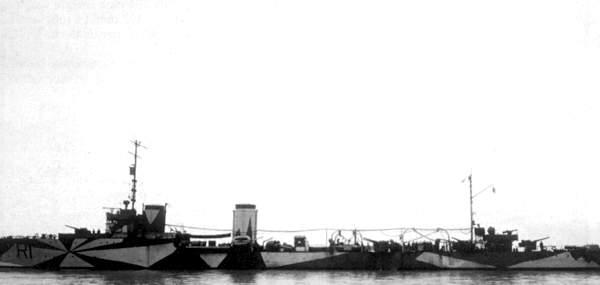
Augusto Riboty in 1942
Armament of Italian destroyers
102 mm/35 (4″) Schneider-Armstrong Model 1914-1915
Was used in destroyers of the Pilo, Audace and Diana classes. Based on a British design, with vertical sliding breech block mechanism. Adopted in 1917. Gun Weight 1.2 tons (1.22 mt). 7 rpm, firing a AP 33.7 lbs. (15 kg) or HE 30.3 lbs. (13.74 kg) shell at 2,461 fps (750 mps).
102 mm/45 (4″) Schneider-Armstrong Models 1917/1919
Used on the Generali, Palestro, La Masa, Sirtori classes and for the M1919 on the Mirabello and Curtatone classes. This was a copy of the Vickers 4″/45 (10.2 cm) Mark V, used in single and twin mountings and vertical rather than standard horizontal sliding breech block. The gun weighted 2.364 tons (2.327 mt), fired an AP 35.3 lbs. (16 kg) or HE 30.3 lbs. (13.74 kg) shell, at a muzzle velocity of 2,789 fps (850 mps).
120 mm/45 (4.7″) Schneider-Canet-Armstrong Model 1918
Used on the Leone, and 1920s classes Sauro, Turbine and Sella. In service by 1919. Weighted 9,600 lbs. (4,354 kg), 7 rpm, firing an HE 48.5 lbs. (22 kg) or AP 51.0 lbs. (23.15 kg) shell at 2,460 fps (750 mps). The 1924 Vickers-Terni model was capable of 2,789 fps (850 mps). The final 1926 OTO model had the same performances.
76.2 mm/40 (3″) Ansaldo 1916 and 1917
Based on the British 3″/40 (7.62 cm) Armstrong 1916/1917. Standard as dual purpose on some Italian destroyers and many auxilaries. Designed in 1893, imported from Elswick and then licence-built. Many (730) were also used on a standard AA mount. Weighted 0.6 tons (510 kg), fired an Italian-manufacture HE 14.3 lbs. (6.5 kg) or AA 13.3 lbs. (6.0 kg) shell at 2,231 fps (680 mps for the HE) and 2,264 fps (690 mps) for the AA round. Lfe of the barrel was around 2500 cycles. A good crew can fire at 15 rpm.
Torpedoes:
Little is known about WW1 Toredo models used by Italy.
By caliber we know there were three in service:
305 mm (12-in): 1890s 3,4th class torpedo boats
380 mm (14-in): 1890-1900 3,4th class torpedo boats
450 mm (18 in): 1900s late torpedo boats and destroyers.
This changed from 1925 with the adoption of the standard 533 mm (21 in) type on the Sella class and following. See ww2 Italian destroyers
The Italians used Thornycroft models built in Italy, of 380 and 450 mm. Many destroyers were rearmed in the interwar by the 53.3 cm (21″) Si 270/533.4 x 7.2 “M” modello. This model weighted 3,748 lbs. (1,700 kg), was 23 ft. 7 in. (7.200 m) long, and carried a 595 lbs. (270 kg) warhead of TNT. powered by a Wet-heater engine, it can speed up to three settings:
4,400 yards (4,000 m)/46 knots
8,750 yards (8,000 m)/35 knots
13,100 yards (12,000 m)/29 knots
This model was built in Naples (Silurificio Italiano) and was later declined into a 48 knots, 38 knots and 30 knots setting mode as used in WW2.
Read More
WW1 Italian destroyers in action
Due to the losses of destroyers during the war it’s safe to assume at first glance Italy did engaged its destroyers in action many time over. Despite a relatively inactive opponent, the Austro-Hungarian Navy, and this story started against Turkey in 1912. Let’s have a look on losses statistics now, 9 destroyers:
-Borea 1917, Nembo 1916, Turbine 1915 (Nembo class)
-Cesare Rosarol (1918)
-Garibaldino (Soldati class) 1918
-Impetuoso 1916, Intrepido 1915 (Indomito class)
-Audace(i) 1916
-Benedetto Cairoli (La Masa) 1918
A bit off-frame: Carlo Mirabello (1920) three TBs class Sirio/Pegaso: Scorpione, Serpente, Perseo, 36 PN (1918).
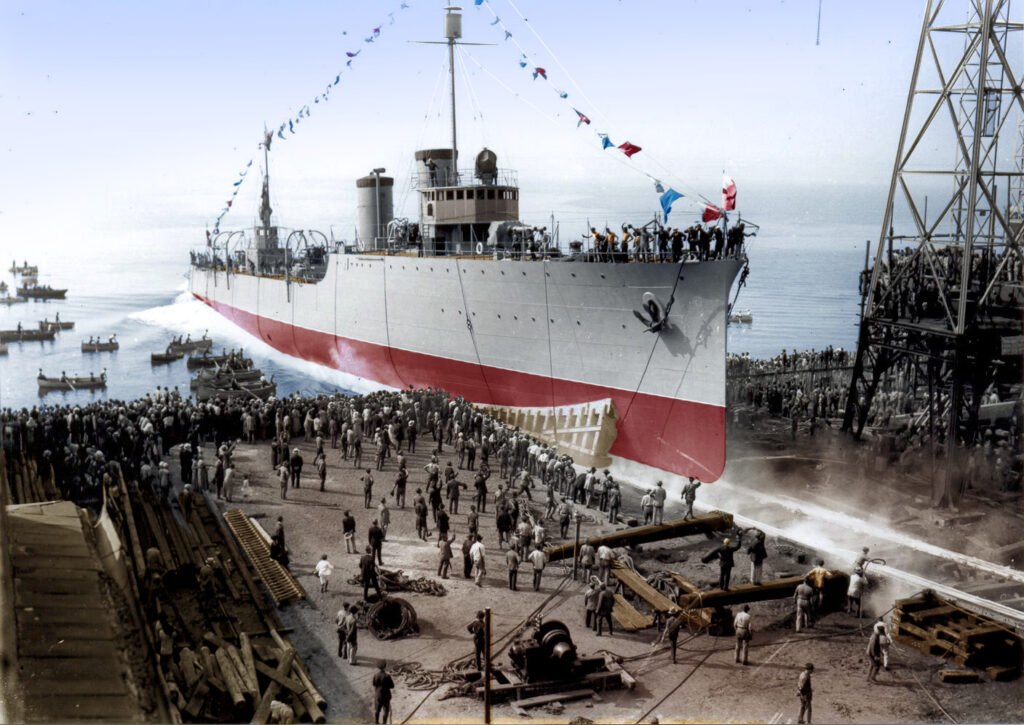
The launch of Leone, colorized by the author
Italian Ammunitions and mines
Results of Italian destroyers were linked to the shift to a local production. Foreign guns and shells performed well, but when the latter ran out, domestic production took over. The result was less favourable to the locally-made ones, wic often failed to detonate or were less accurate, even though the Italian gun direction equipment was of ingenious design and technically well made.
Other innovations were taken in account on torped boats and destroyers alike quite soon, mines, invented and perfected with a system of automatic depth-setting for moored models, credited to Lieutenant Giovanni Elia. They were put to good use in the Adriatic during the war.
Operations against Turkey (1911-12)
The war against Turkey (29 September 1911) gave the opportunity to Italian destroyers to shine in several occasions. They escorted many troopships, a daunting task as 30,000 troops were carried in 55 transports from the peninsula to Libya. Italian destroyers had their chance to prove their aggressive spirit in actions such at Prevesa (September 1911), Santa Maura in the Ionian Sea, and on the Syrian coast, or in the Dardanelles on 16-19 April 1912, and in the Red Sea. They protected the flanks and rear of bombardment fleets off Tripoli and carried and landed troops on 5
October 1911. The same marine troops would later seize Homs, Derna and Benghazi. Destroyers were seen in the 1912 occupation of Rhodes and the other Dodecanese islands.
From an uneasy alliance to war with the entente in 1915
The 1882 Triple Alliance with Germany and Austria-Hungary was a rocky one, especially between Italy and Austria, and the 1913 Naval Convention signed in between the three provided for the three
fleets to collaborate in the Mediterranean in case of war. In that case an Austrian admiral was to be designated combined commander. However this was on paper. In reality Italy and Austria competed openly for naval supremacy in the Adriatic. Italy designed ships to answer those of Austria rather turned towards French and British ones. In the end, Italy was extremely anxious to seize from Austria the areas of Trieste and Trentino, which weighted much in their decision to turn to war against their old alliance members.
Italian destroyers in the first world war
On 24 May 1915, Italy had a numerous fleet with an active personnel of 40,000 and seek from the beginning to sit her domination of the Adriatic. The main problem was the coast was not friendly to deep-water ports. It was rather flat and shallow. Apart Venice there was pretty much nothing as far as Ancona and then Taranto, at least for large vessels. Vast projects were carried out to make Brindisi capable of accepting large ships, but these ports were vulnerable to Austrian attack from the sea as shown by naval bombardments sweeps made in a single day from port to port. This lack of deep water harbors explained why the Italians preferably deployed destroyers, TBs and light ships in the area, or shallow-draught monitors.
The Adriatic east coast featured innumerable islands, with deep waters helping much the Austrian ships to shelter in secluded refuges, and then appear unexpectedly on the open sea. Although Italy had laid down good, modern destroyer classes since 1910 (the 6 Indomito in 1910-11, the 4 Ardito and Animoso in 1912, the 8 Pilo in 1913-14), and the 39 very successful coastal torpedo-boats of the PN, OS, AS and RM types, the Italian Navy found itself short of light warships in the surface war with Austria and against the U-boats in the Mediterrancan.
The Italian battlefleet, to which had been added a few obsolescent British battleships, did gain supremacy in the Adriatic and Ionian Seas, so Italy did not continue building the 4 Caracciolo class super-dreadnoughts, instead devoting her shipyards to building scouts, destroyers, torpedo-boats and submarines.
This construction programme was, unfortunately, restricted by the scarcity of steel, bronze and other materials. As partial compensation for the lack of light ships, the 4 scouts of the Vifor class (building or completing at Naples for the Rumanian Navy) were requisitioned.
The 4 Leone class ships were ordered, but could not be laid down, apparently for the lack of steel, while the 4 Sirtori class destroyers were laid down along with the 8 La Masa types. The 4 Palestro, the 4 Curtatone, the 6 Generali and a further 6 destroyers were also ordered, not one of which (of these 20 destroyers) could be laid down during hostilities. Precedence was given to smaller vessels: a further 30 coastal torpedo-boats were built, while work on a further 10 had to be abandoned.
Also during hostilities no fewer than 63 submarines were launched. But the most Italian torpedo carrier of this period was the MAS boat, of which as many as 299 were built, designed to act as torpedo-boats and for attacking submarines. Up to the end of the war, a further 50 USA-built Mas boats also entered service; these were larger but slower. They were numbered past 450. Dozens more were commissioned after the Armistice, both of the Italian type (fast and light) and of the American type, built in US and Italian yards.
Italian merchant traffic by then was extensive: 684 steamers worth 1,035,815 tons net and 517 sea-going sailing ships (210,814 tons) in 1916. For their escort 47 fishing boats, built in Japan and acquired and armed in 1916-17 were used for escort, but classified as vedette boats, and distinguished by the letter ‘G’ (for ‘Giappone’). To help land operations near the coast with Austria and shell enemy positions, notably around Carso, and Hermada, a number of monitors and self-propelled floating batteries were built or converted. They armed with medium and large-calibre guns up to 15-in, those requisitioned for the cancelled Caracciolo class super dreadnoughts in construction.
To defend Venice threatened by the Austro-German advance in October/November 1917, lighters and barges including some captured ex-Austrian ones and self-propelled and even unpowered floating batteries were converted and armed. This mostly happened at Venice Navy Yard. They fought gallantly in the canals and in the lagoon east of Venice. Furthermore, 57 minesweepers has been laid down, many commissioned in wartime. The fasterst and 16 modern merchant ships were also requisitioned and armed as cruisers, while 13 were converted to hospital ships. Tugs, fishing boats, patrol boats, small steamers were also requisitioned and armed to serve as auxiliary escorts, minesweepers and gunboats. The 1915-1918 cost Italy 8 destroyers and 6 torpedo-boats in addition to 3 battleships and 4 cruisers, 267 aircraft and 7 airships. The end of the war did not prevented the construction of 1 scout and 6 destroyers, and construction restarted for 2 flotilla leaders and 10 destroyers as steel and manpower shortages were no longer there.
War Prizes
As compensation for her own war losses, Italy demanded a Tegetthoff class battleship and one of the Radetsky class to replace the sunken battleships Leonardo da Vinci and Benedetto Brin. It did not obtain the two battleships, but was able to get 3 ex-German light cruisers, 3 ex-German and 9 ex-Austrian destroyers, while 2 small ex-Austrian torpedo-boats (110 tons) joined the Italian Customs Guard.
In addition, 62 ex-Austrian and 17 ex-German auxiliaries and minor vessels were commissioned in the Italian Navy. One oiler, of the 17 German ships, was built under the War Reparation account,
laid down after the war (in 1922) and commissioned in the Italian Navy as Urano; 2 tugs of the 62 Austrian ships found incomplete at Trieste were completed after the war for the Italian Navy. No former U-boats were maintained in working order: in fact, all the U-boats (13 ex-Austrian and 10 ex-German) allotted to Italy after the end of the war were scrapped.
-Premuda (ex-V116)
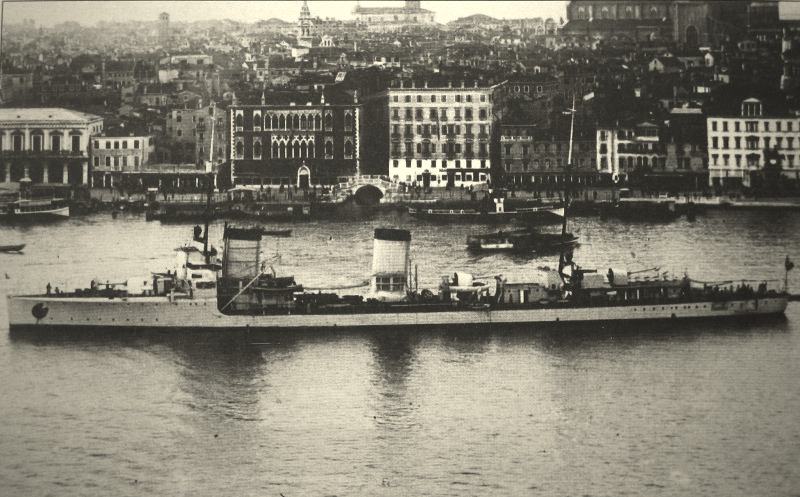
Premuda in Venice
The Vulcan-built 1917 destroyer, launched in March 1918 was a 2555 tonnes vessel, quite impressive compared to usual Italian destroyers. This was one of the Grosse Torpedoboote class built late in the war, transferred to Italy at Cherbourg. The Italians made some alterations to the design: They discarded the 600 mm torpedo tubes and replaced them by German-built 500 mm tubes. Also they added two twin mount Breda 13 mm AA. The ship was also modified to carry up to 40 mines. She was at first classed as a scout (espoloratori) and then destroyer in 1938. Before that she served with the cadets as a schoolship, had her TT replaced by 17.7 in Italian tubes, and a 4.7 in/15 light howitzer was installed on board in 1932. She was stricken on the first January 1939, well before the war began.
-Cesare Rossarol (ex-B97)
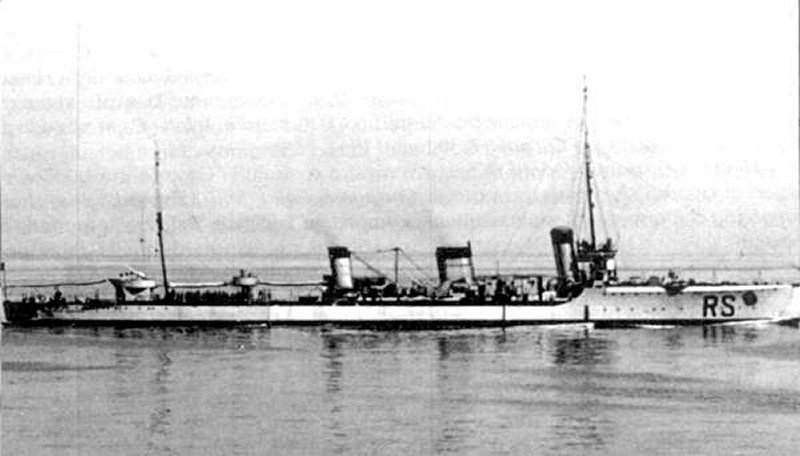
The Blohm & Voss Hamburg destroyer B97, three-funnelled, derived from designs derived from the Russian Novik originally made by Germany for Russia, was also a suitable war prize for Italy. She was also transferred at Cherbourg in 1920, and became an esploratori (scout) due to her size and range, and then destroyer in 1924. Four 105 mm/45 German guns replaced the lighter 8.8 cm guns. Her fore funnel was raised and while the original ship was able to reach 35 knots on paper, on new trials in 1923, at 60% power, the Rossarol reached 26.3 knots. Her top sea speed was around 30 knots. In 1931, her original 500 mm TTs were replaced by Italian 450 mm models. The aft boiler was removed, and a Sperry Gyro-stabilizer added. The next year, Rossarol was used as an experimental ship and disarmed, but in 1935 she was rearmed again and pressed in regular military service. She was however discarded in January 1939.
Ardimentoso (Ex-S49)
A typical hochseetorpedoboote, built at Schichau, and also transferred at Cherbourg. She was recommissioned in 1929 but her TT armament was replaced by Italian 17.7 in tubes, in side mountings and from 1931 she served as a training ship, being stricken in January 1939.
Fasana class destroyers (Ex-Tátra)
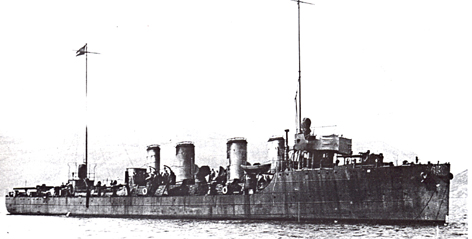
Probably the best prize of all for the Regia Marina were seven ex-Tátra class destroyers: The three originals (one lost) and the four of the improved second serie. These were certainly the best Austro-Hungarian destroyers by far, reaching 33 knots, with a long range and heavily armed. However knowing that these ships would be offered as war prize, the former crews did not maintained them and they were in poor condition when transferred. So much so that Tátra (renamed Fasana) and Balaton (Zenson) were never commissioned and stricken in 1923. The four others were renamed Muggia, Pola, Cortelazzo, Grado and Montfalcone and served with new Italian twin mounts 17.7 in TTs, two 6.5 mm Breda AA MGs. Muggia was lost off Hea Chu island on the coast of China in 1929 while the others were stricken in 1937-39. From 1929 they were classed as torpedo boats.
Conclusion: Italian interwar destroyers
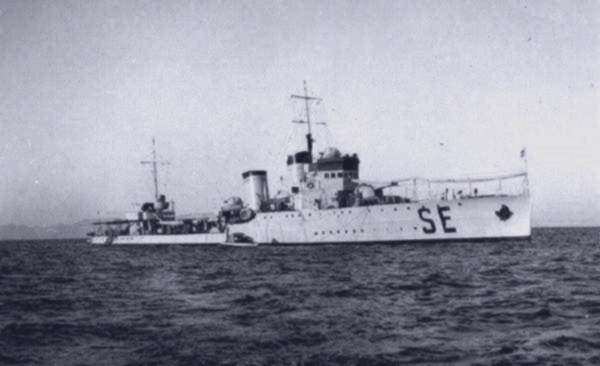
Italy reached the end of the war with about 450,000 metric tonnes (France 700,000 tonnes), so after the signing of the Washington treaties of 1921/1922, the allocated tonnage was good news for Italy by obtaining parity; The scope of naval rivalry then changed towards France instantly. In light forces and submarines, Italy did not obtain parity with France however, even though at first France appeared willing to agree to this. In 1922 the destroyer Quintino Sella was laid down, the first unit of the 1922/1923 naval programme; the first since the end of the war.
Read More – Src
Navi da guerra | R. N. Fulmine 1898 | cacciatorpediniere
La Guerra Italo Turca – Betasom – XI Gruppo Sommergibili Atlantici
Forum Eerste Wereldoorlog :: Bekijk onderwerp – Regia Marina Italiana, 1914-1915
Franco Favre, La Marina nella Grande Guerra.
Beehler, William Henry (1913). The History of the Italian-Turkish War
Chesneau, Roger; Kolesnik, Eugene M (1979). Conway’s All The World’s Fighting Ships 1860–1905.
Fraccaroli, Aldo (1970). Italian Warships of World War 1.
“Lampo”. Purnell’s Illustrated Encyclopedia of Modern Weapons and Warfare.
//www.marina.difesa.it/storia/almanacco/parte05/navi0502.asp Fulmine, Cacciatorpediniere
//www.anmimonza.it/doc/La_Regia_Marina.pdf
//arxiv.org/PS_cache/arxiv/pdf/1002/1002.2888v2.pdf Domenico Pacini,
the forgotten pioneer of the discovery of cosmic rays
//www.steelnavy.com/RMThreePipers.htm
//wargamingmiscellanybackup.files.wordpress.com/2012/04/vmm2012-dd002.jpg
//en.wikipedia.org/wiki/List_of_destroyers_of_Italy
Nomenclature of Italian destroyers
 Fulmine (1912)
Fulmine (1912)
The Fulmine was the first Italian destroyer, and one of the few existing in 1898. It was designed by Chief Engineer Ernesto Martinez in 1896, started in 1897 and in service in 1900. Experimental, it did not give full satisfaction. His hull too low was harmed in heavy weather, its speed lower than expected (26.5 knots expected, 24 painfully reached the tests). Its initial armament consisted of 5 pieces of 57 mm and 3 TLT of 305 mm, too ambitious. In 1901, it passed to 1 piece of 76 mm, 3 of 57 mm and 2 TLT. The fulmine having a short radius of action (800 nautical at 15 knots), it took part only by far in the war of the Balkans and did not see much the fire during the great war. It was demolished in 1920.

Specifications
Displacement: 293 t – 337 t FL
Dimensions: 62.17 x 6.41 x 2.30 m
Propulsion: 2 shafts turbines, 4 Blechynden boilers, 4729 ihp, 24 knots.
Crew: 48
Armament: 1 x 76, 3 x 57 mm, 2 x 305 mm TTs.
 Lampo class (1899)
Lampo class (1899)
In 1899, the Italian Navy ordered six destroyers from the German shipyard Schichau-Werke of Elbing, in Prussia. The design was typical of Schichau hochseetorpedoboote, with a raised turtleback forecastle, as well as a ram bow and two funnels.
60.00 metres (196 ft 10 in) long (62.05 metres overall) for 6.50 metres (21 ft 4 in) wide they Displaceed 315 and up to 348 long tons fully loaded.
Powered by two triple expansion steam engines fed by four Thornycroft water-tube boilers for a total output 6,000 ihp (4,500 kW) they reached 30 knots (56 km/h; 35 mph) as design, around 31 on trials. Coal provision gave them an endurance of 2,000 nautical miles (3,700 km; 2,300 mi) at low cruising speed.
The Lampo, Freccia, Dardo and Euro were armed with a 76 mm (3 in)/40 forward gun, firing 5.9 kg (13 lb) shells to 9,850 metres, at 15 rpm plus five 57 mm/43 guns. Strale and Ostro had an uniform battery of six 57 mm guns and two 356 mm (14 in) torpedo tubes. Laid down in 1899-1900 they were completed in 1900-1902. Fast on trials at 31 knots (57 km/h; 36 mph) seaworthiness was so poor they barely ran at 25 knots in service.
During the Italo-Turkish War Freccia ran aground in a storm off Tripoli by 12 October 1911, and the others operated along the coast of Libya, and Dodecanese. When WW1 broke out, the class was part of the 6th Destroyer Division in Libya. They were modified for minelaying, but were used as escorts off North African and in the Tyrrhenian Sea, fitted with depht charges for ASW patrols. Disposed on in 1922, they were stricken gradually starting in November 1924.
Specifications
Displacement: 315 long tons (320 t) normal/348 fully loaded
Dimensions: 60.00/62.05 m oa x 6.50 m x 2.60 m
Propulsion: 2 VTE steam engines, 4× Thornycroft boilers, 6,000 ihp (4,500 kW)
Speed: 31 knots (57 km/h; 36 mph), Range: 290/2,000 nmi at 12 knots
Complement: 59
Armament: 1 × 76 mm, 5 × 57 mm/43, 2× 356 mm (14 in) TTs
 Nembo class (1901)
Nembo class (1901)
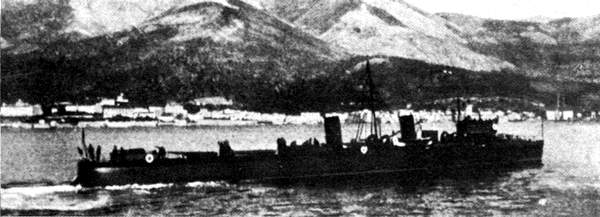
RN Turbine before refit.
In 1899 the Pattison shipyard of Naples received its order for destroyers and submitted a blueprint which was accepted. They were the first destroyers of the yard, and in stark contrast to the previous Lampo class. Indeed they were based on a Thornycroft Thirty-knotter destroyer, such as HMS Stag.
The six Nembo class (Nembo, Turbine Aquilone, Borea, Zeffiro, Espero) measured 64.0 metres (210 ft 0 in) long overall by 5.94 metres (19 ft 6 in) in width for a 2.29 metres (7 ft 6 in) draft. They displaced 325 long tons (330 t) and up to 380 long tons (390 t) fully loaded. Unlike the German design of the Lampo, they had three Thornycroft boilers feeding two triple expansion steam engines for a total output of 5,000 indicated horsepower (3,700 kW). This power was passed on two propeller shafts for a total of 30 knots (56 km/h; 35 mph). They also had a slightly raised turtleback forecastle, and two widely spaced funnels.
They diverged in armament: The Nembo and Turbine had a 76 mm (3 in)/40 gun (5.9 kilograms (13 lb) shell, range 9,850 metres (32,320 ft) 15 rpm) plus five 12-pdr (57 mm/43) guns, and two 356 mm (14 in) torpedo tubes. The other four had five 12-pdr but this freed space for four 356 mm torpedo tubes. On trials, these destroyers were capable of reaching 30.2 knots (55.9 km/h; 34.8 mph) on average, but in practice, fully loaded, this was down to 27 knots and far less in heavy weather.
Nembo and Turbine were finally rearmed in 1905 to match the torpedo armament of the others. In 1908 they were al taken in hands in drydocs for refitting of their powerplant, with new oil-fired boilers. Their appareance was altered as a result, with three funnels rather than two. The increase of oil storage resulted in a range of 330 nautical miles (610 km; 380 mi) at 25 knots and up to 2,200 nautical miles (4,100 km; 2,500 mi) at economical speed of 9 knots. Also the armament was altered again, with the 12-pdr disposed of in favour of four 76 mm/40 guns but less TTs, just two 450 mm (18 in), compensated by the larger caliber.
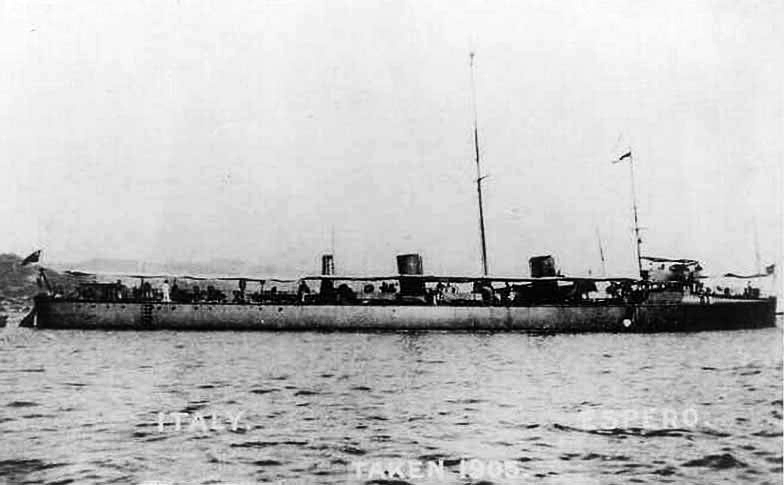
RN Espero before refit (1905)
The six destroyers participated actively in the Italo-Turkish War of 1911–1912, fitted for minelaying (10–16 mines). Three were lost in action during WW1 and the survivors saw a boiler removed, also with a funnel and a 76 mm gun to make them lighter. They were reclassified as torpedo boats and discarded in 1923.
Specifications
Displacement: 315 long tons (320 t) normal/348 fully loaded
Dimensions: 60.00/62.05 m oa x 6.50 m x 2.60 m
Propulsion: 2 VTE steam engines, 4× Thornycroft boilers, 6,000 ihp (4,500 kW)
Speed: 31 knots (57 km/h; 36 mph), Range: 290/2,000 nmi at 12 knots
Complement: 59
Armament: 1 × 76 mm, 5 × 57 mm/43, 2× 356 mm (14 in) TTs
 Soldati class (1906)
Soldati class (1906)
These light vessels, of the “high seas torpedo boat” type of this time, derived from the Nembo but designed to rech 28 knots and more. They were designed by Ansaldo in Genoa, the specialist in light units. The first six ships of the series (Artigliere, Bersagliere, Granatiere, Corazziere, Garibaldino, and Lanciere), burned coal and had Thornycroft boilers. They initially had a short mast that was raised when they received the wireless telegraphy.
The second group included AIpino, Fuciliere and Pontiere, walking on oil and launched in 1909-10. They had the typical defect of units of this generation, poor behavior in heavy weather and limited autonomy. They all survived the war except the Garibaldino, which sank in July 1918 following a nightly collision with HMS Cygnet. Their disarmament took place in 1923-29, but by 1921 they had been reclassified as torpedo boats.
Author’s profile of the Soldati class
Specifications
Displacement: 394-424 tons FL
Dimensions: 65 x 6 x 2 m
Propulsion: 2 shaft VTE, 3 Thornycroft boilers, 6000 hp, 28-29 knots.
Crew: 55n.
Armament: 4 x 76 mm, 3 x 450 mm TTs, 10 mines.
 Indomito class (1912)
Indomito class (1912)
Defined by the admiralty as a new generation of destroyers, equipped for the first time with turbines, the Indomito were designed by engineer Luigi Scala from Pattison in Naples. This drawing was so successful that it gave rise to a long line of “cane” (three pipes) until the early twenties, including no less than 5 classes very similar. In addition to their turbines, giving them 35 knots and more, they were 350 tons heavier and better armed than the old Nembo and Soldati. Only their armament in torpedoes (two tubes) was considered insufficient and strengthened thanks to the installation of two twin banks.
Short stern rails were also fitted for the boarding of 10 mines. Their oil capacity was also increased, and the Impetuoso was sunk on July 10, 1916 by U17 in the Strait of Otranto and Intrepido on December 4, 1914 near Valona by UC14. In addition to these 6 buildings, the Ardito and Ardente were launched in 1912 in Orlando, Leghorn, bringing the class to 8 units. In 1929 they were reclassified as torpedo boats. The Insidioso participated in the second world war and was sunk in 1944, the others being erased in 1937.
Indomito class destroyers
Specifications
Displacement: 770-850 tonnes FL
Dimensions: 73 x 7.3 x 2.7 m
Propulsion: 2 shafts Tosi turbines, 4 Thornycroft boilers, 16,000 hp, 35.5 knots.
Crew: 79 men.
Armament: 1 x 120mm/40, 4 x 76 mm/40 DP, 2 x 450 mm TTs, 10 mines.
 Ardito class (1913)
Ardito class (1913)
Near-copy-paste of the Indomito class, but designe by Orlando shipyards at Leghorn. In 1915 their single TTs were replaced by twin mountings whereas their deck receive rails for mines. by 1918 and up to 1920 thy received new 4-in/35 guns plus a single 40 mm/40 AA gun and two 6.5 mm Breda AA MG. Reclassed as TBs and discarded in 1931 (Ardito) and 1937 (Ardente).
Specifications
Displacement: 695-790 tonnes FL
Dimensions: As indomito
Propulsion: 2 shafts Tosi turbines, 4 Thornycroft boilers, 15,730 hp, 33.4 knots.
Crew: 68 men.
Armament: As Indomito
 Audace class (1914)
Audace class (1914)
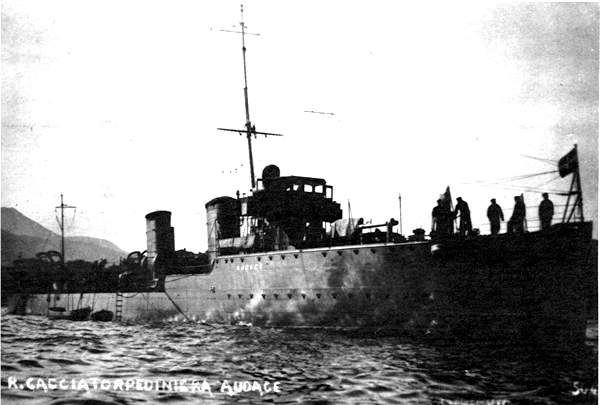
Audace and Animoso were made at Orlando Yard, base don Indomito design from Pattison. They tried Swiss Escher-Wyss turbines which gave no satisfaction. These were replaced later by Zoelly turbines combined to White Forster boilers. Designed for 30 knots they exceeded these figures. With 15,000 hp Audace reached 36.1 knots, the best ever performance by any Italian destroyer so far. Range was 950 nm at 14 knots down to 300 at 27 knots.
They were armed as the Indomito class and recoignisable to their two funnels. Audace sank after a collision in August 1916 in the Ionian sea with SS Brasile while secorting a convoy by night. Animoso was rearmed like other destroyers of the Indomito class in 1916, two 40 mm/40 DP but retained her original two TTs. She suffered a booiler explosion on 29 July 1921 and was paid off and stricken in 1923. See a 2 view tech drawing
Specifications
Displacement: 750-840 tonnes FL
Dimensions: 75.5 x 7.5 x 2.6 m
Propulsion: 2 shafts Zoelly turbines, 4 Thornycroft boilers, 16,000 hp, 36 knots.
Crew: 75 men.
Armament: As Indomito
 Pilo class (1915)
Pilo class (1915)
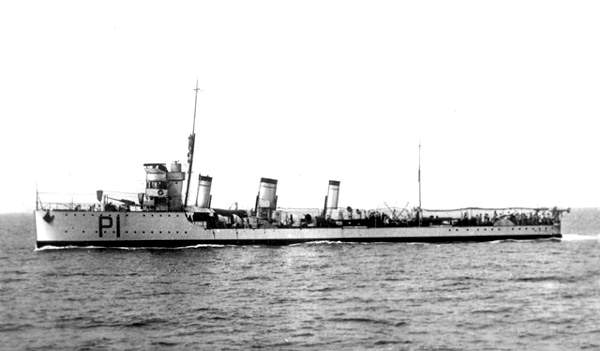
Based on the Insidioso of 1912-13, the Pilo were a complete repetition of the same design, with some minor differences: They abandoned their unique 4.7 in (120 mm) gun in favor of six 3-in (76 mm) including two AA guns, two mine rails and two twin banks for 450 mm TTs.
These were 8 ships ordered at the beginning of the war, built in Odero, Sestri, and two in Pattison of Naples, with autonomy progressed thanks to new larger tanks carrying 150 tons of fuel oil, and cruise turbines, giving them a lower speed but being more resilient. They suffered no casualties during the war and were reclassified in 1929 as torpedo-boats and rearmed. They were all on duty during the Second World War.
Specifications
Displacement: 770-850 tons FL
Dimensions: 73 x 7.3 x 2.7 m
Propulsion: 2 shafts Parsons turbines, 4 Thornycroft boilers, 17,000 hp, 30 knots.
Crew: 79 men.
Armament: 4 x 76 mm, 2 x 76 mm AA, 4 x 450 mm TTs, 10 mines.
 Audace (ii) (1916)
Audace (ii) (1916)
This unique ship with a long and eventful career was actually an order placed by Japan at Yarrow’s English shipyard in 1915. She was supposed to be a sister-ship of Urakaze. Finally, following an agreement with Japan after the entry into the war of Italy, the Kawakaze was transferred, not yet completed, July 5, 1915, and renamed Intrepido, then launched on September 27, 1916 and renamed again Audace, second name (the first was sunk in August).
Her machines, initially delivered by Germany, were never mounted, and the ships was given a classic British propulsion. Finally, she was rearmed entirely by the Italian, quite heavily. Audace(ii) served as a test ship for the side-mounted dual torpedo banks, and gave full satisfaction in service. After 1929, she served as a San Marco radio control vessel, used as a target ship. In 1939, she was operational as a destroyer and rearmed in 1942. Captured by the Germans in October 1943 and renamed TA20 she was sunk in November 1944 during a memorable artillery duel in front of Zara (Dalmatian coast) against the escort destroyers HMS Avon Vale and Wheatland.
Audace destroyer appearance by the author
Excellent documentary (in Italian) about the 2016 discovery of the wreck of the Audace in German service (TA20) and last wartime action in November 1944.
Specifications
Displacement: 922 – 1170 tons FL
Dimensions: 87.5 x 8.3 x 2.5 m
Propulsion: 2 shaft Brown-Boveri turbines, 3 Yarrow boilers, 22,000 hp, 35 knots.
Armament: 2 x 102mm/30, 2 x 40 mm AA, 4 x 450 mm TTs, 10 mines.
Crew: 118 men.
 Sirtori class (1916)
Sirtori class (1916)
These four ships were designed as improved Pilos, built at Odero and operational in the course of the year 1917. Their artillery was much larger, and their torpedo tubes banks were placed on the flanks. They were active during the Great War.
In 1920 they had their 102 mm/35 wapped for /45 caliber. In 1929 they were reclassified as torpedo boats, and they served during the Second World War. They served as a model for the La Masa class destroyers launched in 1917-19, four of which were operational in 1918: La Masa, Bassini, Cairoli and Carini. The Benedetto Cairoli was the only loss “in action” after a fatal night collision with the Carini in the Ionian Sea on March 10, 1918.
Specifications
Displacement: 790-850 tons FL
Dimensions: 73.5 x 7.3 x 2.8 m
Propulsion: 2 shafts Tosi turbines, 4 Thornycroft boilers, 15,500 hp, 30 knots.
Crew: 85 men.
Armament: 6 x 102, 2 x 40 mm AA, 2 HMGs, 4 x 450 mm TTs, 10 mines.
 La Masa class (1917)
La Masa class (1917)
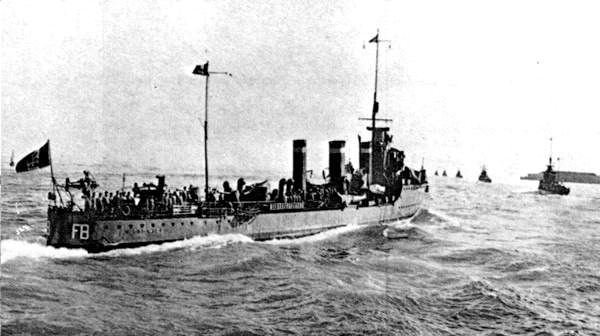
Nicola Fabrizi
This class was an enlargement and improvement of the Audace (i) class, laid down in 1912 and launched in 1913. Eight destroyers were ordered by the Italian Navy from Orlando on 31 December 1915, but owing to lack of steel and other materials only the first four (Palestro class) could be laid down in wartime, late in April-May 1917, and completed after the end of the war (from
January 1921 to April 1923). In 1930 their fore funnel was remarkably lengthened. On 1 October 1938 the ships were reclassed as torpedo-boats.
Immediately before World War Two, it was projected to replace the central 4in gun and the two 3in AA guns with 4-20mm MGs (1×2, 2×1), but this plan was not carried out. Confienza sank in collision with the AMC Capitano A Cecchi off Brindisi. Palestro sank off Durazzo by a torpedo from HM Submarine Osiris.
San Martino captured by the Germans in the Piraeus on 9 September 1943, recommissioned under German colours on 28 October with the designation TA 18, changed on 16 November to TA 17. Her German armament was: 3-4in/45, 6-20mm/65 MGs, 4-17.7in TT. Severely damaged at Piraeus 18 September 1944 by British bombing and sunk there by another British air raid Solferino captured by the Germans in Suda Bay (Crete) on 9 September 1945, recommissioned 25 July 1944 under their colours as TA 18, with 4-4in/4, 2-20mm/65 MGs, no TT. Sunk off Volos (Greece) in action with the British destroyers Termagant and Tuscan.
Specifications
Displacement: 785-851 tonnes
Dimensions: As Sirtori
Propulsion: As Sirtori but range 2230 nm/12.5 knots
Crew: 78 men.
Armament: As Sirtori
 Palestro class (1917)
Palestro class (1917)
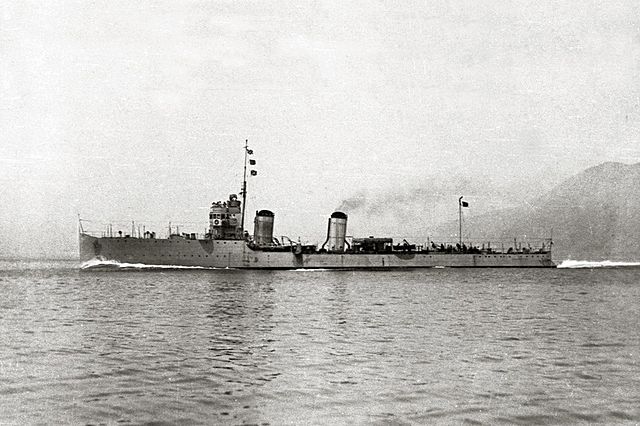
An improvemnent of the La Masa class and therefore the 4th series of improved Indomitos, with only 3-4in guns, but placed in the centre line, so the broadside firepower was the same. All reclassed as torpedo-boats on 1 October 1929.
From 1939 the 2-3in/40 AA guns were replaced by 4-20mm/65 and from 2 to 4-8mm MGs. Cantore sunk by mine off Ras-el-Tin (Libya). Cascino scuttled at La Spezia. Chinotto sunk by mines, off Palermo. Montanari scuttled at La Spezia, by her own crew on 9 September 1943; rescued by the Germans, but not employed by them, and again scuttled. Wreck refloated 1949 and scuttled.
Papa scuttled at La Spezia by her crew, captured by the Germans who recommissioned her on 17 October 1943 as TA 7, but next day renamed again as SG 20. New German armament: 2-37mm/54, 16-20mm/65 or 70 MGs. Damaged by mine 1 November 1943; sunk 6 January 1944 in Genoa harbour and towed to beach on 12 January. Hit by aircraft bombs. Wreck towed to Oneglia for blocking that harbour and sunk at its entrance, Prestinari sunk by mine off Sicily.

San Martino
Palestro class Specifications
Displacement: 875-1076 tons FL
Dimensions: 81.9 x 8 x 2.8 m
Propulsion: 2 shafts Zoelly turbines, 4 Thornycroft boilers, 18,000 hp, 31 knots.
Crew: 118 men.
Armament: 4x 102mm/40, 2x 40mm/40 AA, 2 HMGs, 2×2 450 mm TTs, 10-38 mines.
Improved INDOMITO (5th series) class destroyers
The Italian Navy ordered another class of six-700 metric tonnes destroyers from Pattison Yards, of Naples (names not yet allotted), but cancelled it by the end of the 1914-18 war.
 Generali class (1918)
Generali class (1918)
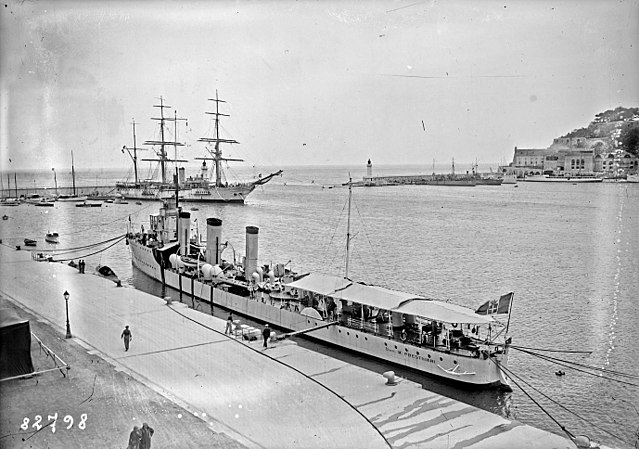
Generale Marcello 1923 – Prestinari src: Agence Rol
This class, designed by Odero Yards of Sestri Ponente, was also known as the third series of the improved Indomitos, and repeated the Sirtori class with some alterations: only 4-4in guns, but 45 calibres long and differently placed 2-3in/40 AA guns instead of the 2-40mm/39 MGs. Benedetto Cairoli sank, at night, in the Ionian Sea, after colliding with her sister ship Giacinto Carini.
Agostino Bertani was renamed Enrico Cosenz on 16 January 1921. The ships were reclassed as torpedo-boats on 1 October 1929. La Farina sunk near buoy no 4 off Kerkennah Is (Tunisia), probably by mine. During the Second World War the armament was modified: Bassini, Cosenz, Fabrizi and Medici had 3 or 2-4in/45 guns, 6-20mm/65 MGs and 2 or 4-17.7in TT; Carini and La Masa
had 1-4in/45, 8-20mm/65 MGs, 3-2lin (1×3) and 2-17.7in (1×2) TT.
Bassini was sunk in Leghorn harbour by bombing. Cosenz (ex-Bertani) damaged in collision with SS Ulisse, on 25 September 1943 off Lagosta; severely damaged by German bombs; scuttled by her crew at Lagosta. Carini converted to minesweeper in 1953; stricken from the Naval List, but used for several years as a
training hulk for schools (distinctive letters: GM 517) at La Maddalena, Sardinia. Fabrizi converted to minesweeper in 1952. La Masa scuttled in Naples harbour, where she was under repair. Medici sunk in Catania harbour, by aircraft bomb; her wreck refloated in 1952 and scrapped.
‘Generali’ class Specifications
Displacement: 810-870 tons FL
Dimensions: 73.5 x 7.3 x 2.7-3.0 m
Propulsion: 2 shafts Tosi turbines, 4 Thornycroft boilers, 15,500 hp, 32 knots
Crew: 106 men
Armament: 3x 102mm/45, 2x 40mm/40 AA, 2×2 450 mm TTs
 Curtatone class (1920)
Curtatone class (1920)
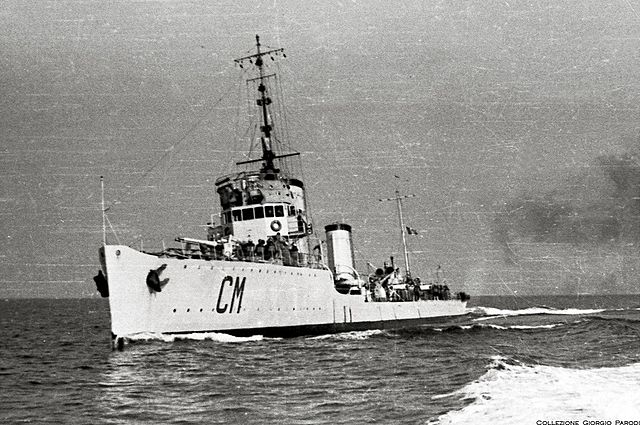
Ordered by the Italian Navy on 31 December 1915, at the same time as the 4 Palestros, but, owing to lack of steel, their construction was postponed and their design – originally identical to the Palestros – was modified on the basis of the experience gained with the name ship of that class.
The Curtatone class were 4.51 m longer also for attaining a higher speed, and were fitted with twin mountings for the 4in guns and triple mountings for the TTs: These were respectively the first twin gun mountings and the first TT triple mounting aboard Italian destroyers. The first ship, Curtatone, was laid down on 3 January 1920. As for the Palestros, their fore funnel was considerably lengthened circa 1930-32.
Reclassed as torpedo-boats 1 October 1938. During World War 2, two of the 2-3in guns were replaced by 2-20mm/70 MGs and 2-8mm MGs were added. Curtatone was sunk by the explosion of one or two mines in Saronikos. In 1942-43 Calatafımi’s and Monzambano’s aft twin gun mounting was replaced by one single gun, and Calatafimi’s 6–17.7in TT were replaced by 2-2lin TT (1×2). For WW2 career see the page about ww2 Italian destroyers.
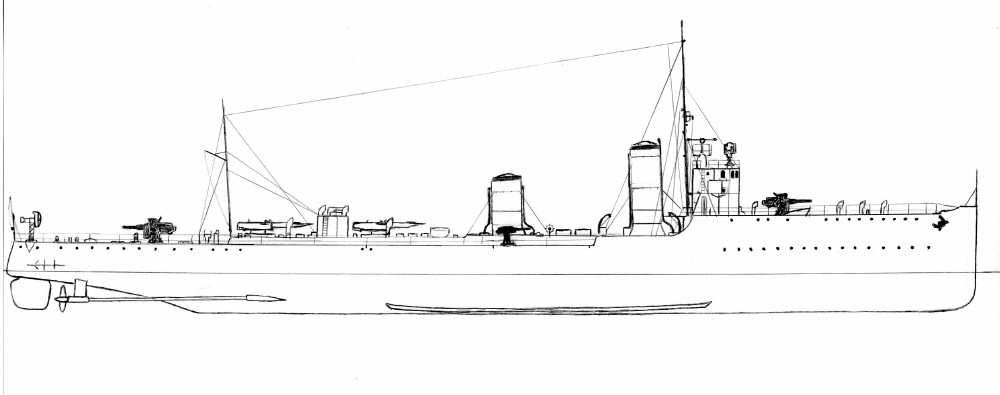
Curtatone in 1942.
Curtatone class Specifications
Displacement: 1107-1214 tons FL
Dimensions: 84.7 x 8 x 3 m
Propulsion: 2 shafts Zoelly turbines, 4 Thornycroft boilers, 22,000 hp, 33 knots.
Crew: c110 men.
Armament: 4x 102, 2x 40 mm AA, 2×3 450 mm TTs, 16 mines.
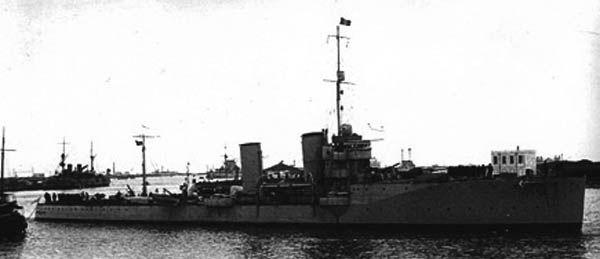
Cesare Rossarol
In 1912 the Admiralty, like Great Britain, launched several classes of heavy destroyers, leaders and flotilla scouts. However, they had the classification of “scout cruisers”. The first, started at Ansaldo of Genoa, were Alessandro Poerio, Gugliemo Pepe, and Cesare Rossarol, started in June-July 1913. They were launched in August-September 1914 and completed in May-August 1915.
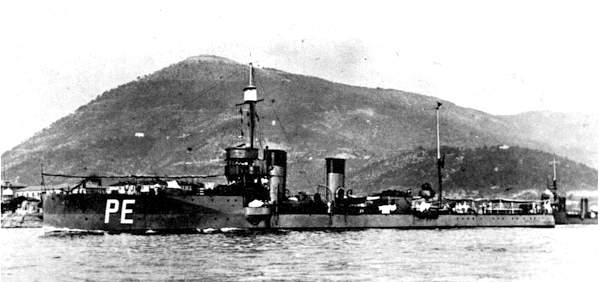
The Esploratori Gugliemo Pepe
They had a powerful armament, with no less than 2 quads of torpedo tubes, but only 4 pieces of 102 mm, which was later changed into two double benches and 6 pieces. With 20,000 hp, they could sail at 31 knots. Shortly after admission to service, the Pepe was equipped with two pieces of 76mm DCA, removed in 1917 when these three buildings were equipped with two 40mm Vickers quick-fire guns. Finally in 1918 they were rearmed with pieces of 102 mm 45 calibres of the new model (instead of 35 originally).
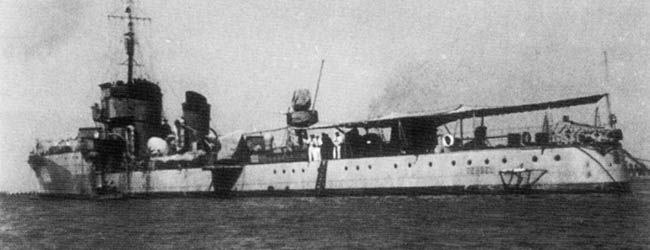
Destroyer Teruel in Spanish service
The war had just ended in a few days when the Rossarol jumped on a mine on November 16, 1918. In 1921, they were reclassified as destroyers, which was more in line with their tonnage, and while the Pepe served as a test ship for a Sperry gyrostabilizer, the two ships were removed from the lists in June 1938 and transferred to Nationalist Spain, which actively implemented them. Renamed Teruel and Huesca, they were demolished only in 1947-49.
Illustration of the Alessandro Poerio by the author
Specifications
Displacement: 1030t, 1216t. FL
Dimensions: 85 x 8 x 3 m
Propulsion: 2 shaft turbines Belluzzo, 4 Yarrow boilers, 20,000 hp, 32 knots
Crew: 129
Armament:6 x 102 mm, 4 x 450 mm (2×2) TTs, 42 mines.
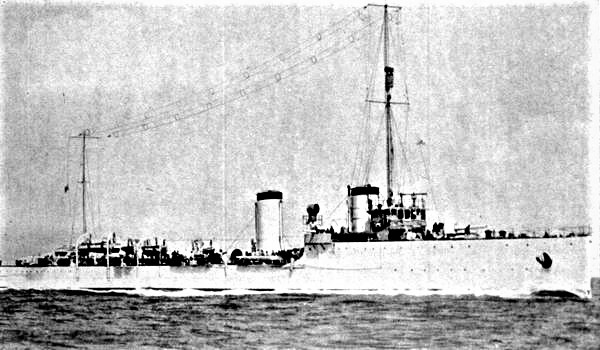
These three “scout-cruisers” were defined according to the same specifications as the previous three Poerio, but the 1913 plan provided for buildings with an autonomy worthy of light cruisers, armor and heavier weaponry, which required a tonnage increased to 5,000 tonnes.
The company Ansaldo from Geneva, appointed commissioner, worked with the engineer Nabor Soliani to design an economic compromise between a cruiser of 5,000 tons and destroyers like the Poerio. They were started in Nov-Dec. 1914 and February 1915 and put into service in August and September 1916 and April 1917. The class included Carlo Mirabello, Carlo Alberto Racchia and Augusto Riboty, classified as scout cruisers.
The Mirabello were much heavier and taller than the first, with their large hulls making it possible to build Parsons turbines and large Yarrow boilers, for a final speed of 35 knots or more at testing. They varied considerably in armament, the Racchia and the Riboty being equipped with seven 102 mm guns and a single 152 mm on their forecastle, armament copied in 1917 by the Mirabello, but abandoned for the three in 1919, because their hull was too light to accommodate such a piece of artillery and it causes stability problems.
In 1922, they saw two 40 mm AA Vickers guns installed in addition of their old 76 mm guns. The Racchia hit on a mine off Odessa, July 21, 1920, while in support to the “white” Russians, and the other two saw action during the Second World War alongside the three Leone of the same model launched in 1924, before the latter were sent in Abyssinia. The Mirabello hit on a mine 21 May 1941 off the Albanian coast, and the Riboty was rearmed twice and finally disarmed in 1951.
Illustration of the Carlo Mirabello by the author
Specifications
Displacement: 1785t, 1970t. FL
Dimensions: 103.7 x 9.7 x 3.3 m
Propulsion: 2 shafts Parsons turbines, 4 Yarrow boilers, 44,000 hp. and 33-35 knots
Crew: 169
Armament: 8 x 102, 2 x 76 AA, 2 MG, 2 x 450 mm TTs, 100-120 mines.
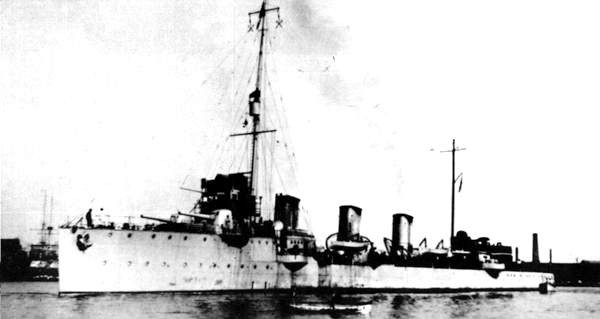
Originally these four destroyers had been ordered by the Romanian government at the Pattison shipyards of Naples. They wanted to oppose the fast and very well armed Russian destroyers of the Black Sea fleet. Designed by Luigi Scaglia in 1913, they were originally designed to accommodate three 4.7 in guns (102 mm) and five TTs, and make a 10 hours run at full speed. The requisition came on June 5, 1915 when the three units were under construction by the Italian government, which had chosen the side of the triple entente.
But construction was difficult because of the lack of manpower and equipment, and Aquila was launched in July 1917, Nibbio in March 1917 and Sparviero in January 1918 while Falco was delayed launched until August 1919. Finally, they entered all but the last in service in February 1918 (Aquila), July 1917 (Sparviero) and April 1918 (Nibbio). Falco was not completed until 1920. They had been rearmed with the intended three 6-in guns 152 mm to replicate to the Austro-Hungarian scout cruisers of the Spaun class, but their weight and slow rate of fire had them removed after the war. Two were sold to Nationalist Spain in January 1939 (Melilla and Ceuta) and two were purchased as intended first by Romania in July 1920 as Mărășesti and Mărăști (or Marasesti and Marastià.
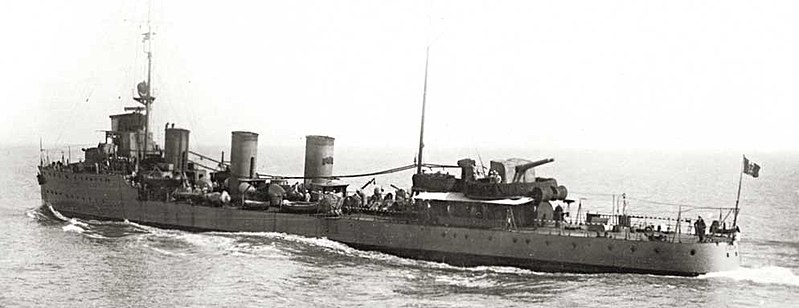
Romanian scout Mărăști in the black sea
In 1920, the Nibbio and the Sparviero after being transferred to their first sponsors were quite active during WW2 in the blac sea. See the Romanian navy in WW2 for more. The Melilla and Ceuta served with the Spanish Navy in WW2 remaining neutral and making patrols, until they were discarded in 1948. A good service span for ships designed in 1913 !
Illustration of the Aquila by the author
Specifications
Displacement: 1600t, 1730-60t. FL
Dimensions: 94.7 x 9.5 x 3.6 m
Propulsion: 2 shafts Tosi turbines, 5 Thornycroft boilers: 39,500 hp. 38 knots.
Crew: 146
Armament: 3 x 152, 6 x 76, 2 MG, 4 x 450 mm TTs (2×2), 24-44 mines.

These powerful destroyers were actually considered scouting cruisers during their construction. The two Mirabello in 1916, and the three Leone in 1923. Pretty close in terms of their general conception, the Leone were much larger and heavier. The first, 2,000 tons, participated in both conflicts, and the second, of 2300 tons, only the last.
They were known in the fleet as “scouts”, and were reclassed as destroyers in 1938. They had great firepower. Both classes had 8 pieces of 102 mm and two guns of 40 mm originally. In 1938, 13.2 mm heavy machine guns were added to these ships, and in 1943 the Riboty (Mirabello class) received 20 mm guns instead of four of their 102 mm guns.
The Riboty survived the conflict and although offered to Russia in war damage, refused and BU in Italy in 1951. The Mirabello was sunk by a mine in 1941. The three Leone received a few 13.2 mm machine gun mounts and were used during the conflict although their design was old (they were designed to support the Mirabello in 1917, but their construction stopped due to a lack of resources and manpower). All three were scuttled in March 1941 in Marsawa, Abyssinia, in the end of the East African campaign.

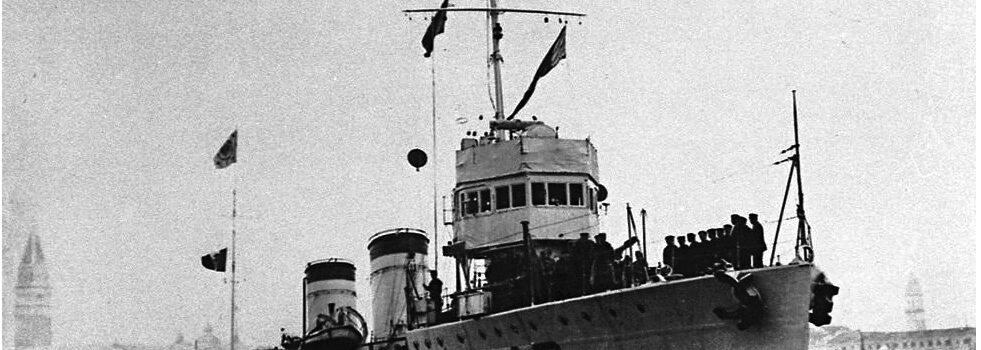







 Latest Facebook Entry -
Latest Facebook Entry -  X(Tweeter) Naval Encyclopedia's deck archive
X(Tweeter) Naval Encyclopedia's deck archive Instagram (@navalencyc)
Instagram (@navalencyc)





 French Navy
French Navy Royal Navy
Royal Navy Russian Navy
Russian Navy Armada Espanola
Armada Espanola Austrian Navy
Austrian Navy K.u.K. Kriegsmarine
K.u.K. Kriegsmarine Dansk Marine
Dansk Marine Nautiko Hellenon
Nautiko Hellenon Koninklije Marine 1870
Koninklije Marine 1870 Marinha do Brasil
Marinha do Brasil Osmanlı Donanması
Osmanlı Donanması Marina Do Peru
Marina Do Peru Marinha do Portugal
Marinha do Portugal Regia Marina 1870
Regia Marina 1870 Nihhon Kaigun 1870
Nihhon Kaigun 1870 Preußische Marine 1870
Preußische Marine 1870 Russkiy Flot 1870
Russkiy Flot 1870 Svenska marinen
Svenska marinen Søværnet
Søværnet Union Navy
Union Navy Confederate Navy
Confederate Navy Armada de Argentina
Armada de Argentina Imperial Chinese Navy
Imperial Chinese Navy Marinha do Portugal
Marinha do Portugal Mexico
Mexico Kaiserliche Marine
Kaiserliche Marine 1898 US Navy
1898 US Navy Sovietskiy Flot
Sovietskiy Flot Royal Canadian Navy
Royal Canadian Navy Royal Australian Navy
Royal Australian Navy RNZN Fleet
RNZN Fleet Chinese Navy 1937
Chinese Navy 1937 Kriegsmarine
Kriegsmarine Chilean Navy
Chilean Navy Danish Navy
Danish Navy Finnish Navy
Finnish Navy Hellenic Navy
Hellenic Navy Polish Navy
Polish Navy Romanian Navy
Romanian Navy Turkish Navy
Turkish Navy Royal Yugoslav Navy
Royal Yugoslav Navy Royal Thai Navy
Royal Thai Navy Minor Navies
Minor Navies Albania
Albania Austria
Austria Belgium
Belgium Columbia
Columbia Costa Rica
Costa Rica Cuba
Cuba Czechoslovakia
Czechoslovakia Dominican Republic
Dominican Republic Haiti
Haiti Hungary
Hungary Honduras
Honduras Estonia
Estonia Iceland
Iceland Eire
Eire Equador
Equador Iran
Iran Iraq
Iraq Latvia
Latvia Liberia
Liberia Lithuania
Lithuania Mandchukuo
Mandchukuo Morocco
Morocco Nicaragua
Nicaragua Persia
Persia San Salvador
San Salvador Sarawak
Sarawak Uruguay
Uruguay Venezuela
Venezuela Zanzibar
Zanzibar Warsaw Pact Navies
Warsaw Pact Navies Bulgaria
Bulgaria Hungary
Hungary

 Bundesmarine
Bundesmarine Dutch Navy
Dutch Navy Hellenic Navy
Hellenic Navy Marina Militare
Marina Militare Yugoslav Navy
Yugoslav Navy Chinese Navy
Chinese Navy Indian Navy
Indian Navy Indonesian Navy
Indonesian Navy JMSDF
JMSDF North Korean Navy
North Korean Navy Pakistani Navy
Pakistani Navy Philippines Navy
Philippines Navy ROKN
ROKN Rep. of Singapore Navy
Rep. of Singapore Navy Taiwanese Navy
Taiwanese Navy IDF Navy
IDF Navy Saudi Navy
Saudi Navy Royal New Zealand Navy
Royal New Zealand Navy Egyptian Navy
Egyptian Navy South African Navy
South African Navy






























 Ukrainian Navy
Ukrainian Navy dbodesign
dbodesign